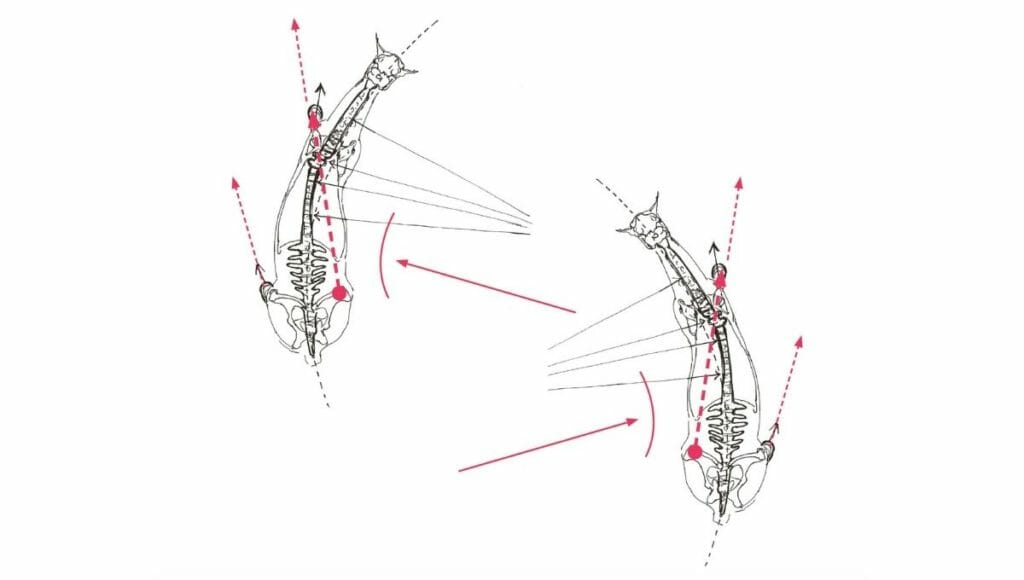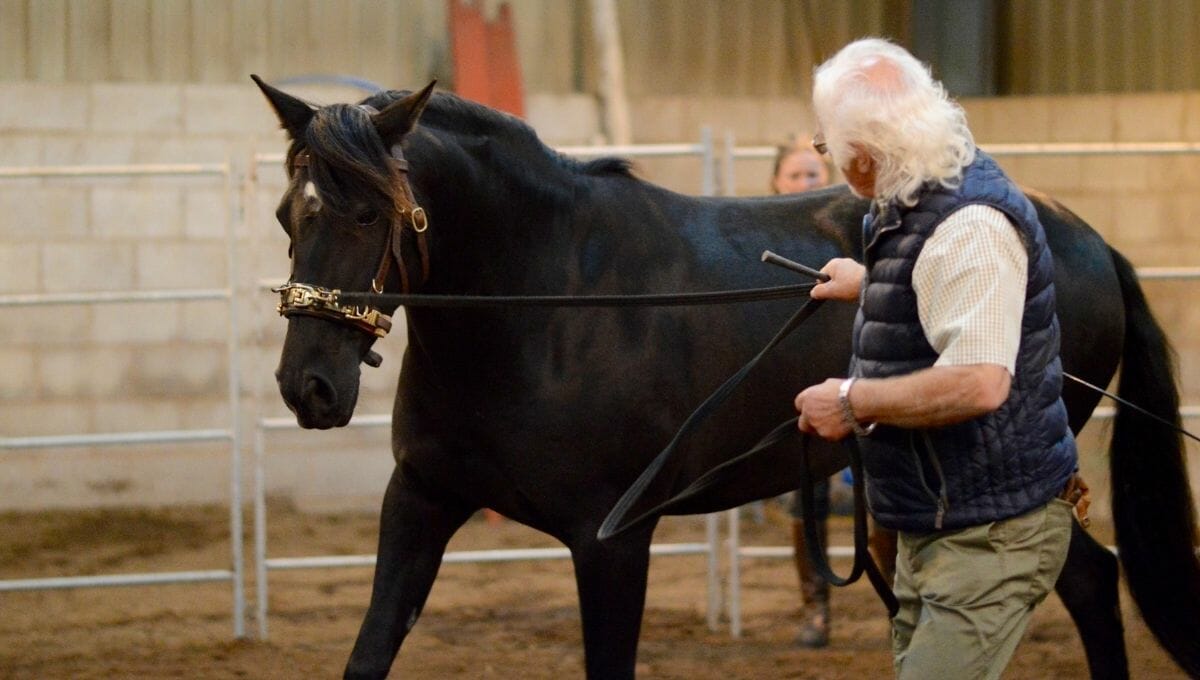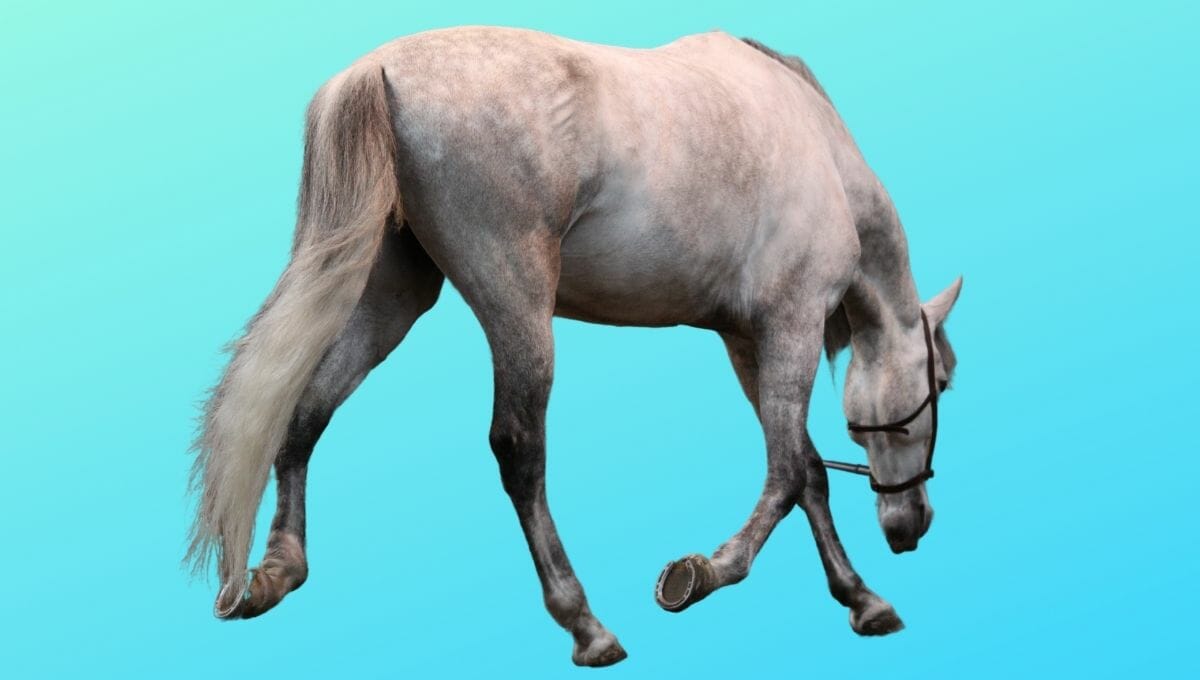Our top tip for having a calm, relaxed, well-muscled and athletic horse, capable of performing in any discipline and staying sound is to check out the work and equine training of Klaus Schoeniech.
For over 25 years the Schoeneichs have taught their system of functional horse training at the Centre for Anatomically Correct Horsemanship in Germany.
Klaus Schoeneich is a true master with a system for horse straightness training that truly helps all horses find a posture that will aid them when ridden in any discipline.
Improving posture through functional horse training
If you have read the book ‘Correct Movement in Horses’ by the Schoeneichs you will know that they have, for over 25 years, been concerned with improving the straightness and balance of horses to aid soundness and ridden longevity. They do this though functional horse training.
If you haven’t read this book then endeavour to make it the number one position on your bookshelf! Then find out where Herr Schoeneich is lecturing or teaching or working with horses and make it your mission to listen to him instruct about horse biomechanics and the way to change quite ordinary or compromised horses into majesty.
Meeting Herr Schoneich listening to him talk, listening to his passion, watching him work, watching him teach others is an inspiration. His energy, enthusiasm and skill are quite extraordinary.
Watching the horses learn to balance by themselves and find the pleasure and calmness in a bio-mechanically positive posture and way of moving is spell-binding and it is something that you can learn to do with your own horse.
What is the horse’s natural posture?
The horse has evolved a natural posture to make him safe in the wild from predators. As a flight animal horses are hard wired to have a flight posture which equips them for the speed to escape danger which threatens their lives. Humans harness this speed when racing horses. Those flight instincts and posture remain deeply anchored in our riding horses. It is this natural posture that often conspires against the horse when we sit upon them and ask them to carry our load and navigate corners.
We may believe that the horse is not in a flight posture but most horses never learn how to carry the weight of a rider on their back so the back is up. They need to be taught a helpful posture through functional horse training.
When a horse is in the flight posture it carries the head high and uses the underneath chain of muscles in the neck and stomach to balance. In this pose the shoulders are pushed down by the trapezius muscle and the horse is fixed on its forehand.
In this posture the back legs stay on the ground for a long time to develop higher thrust. This means the the back is pressed down and the neck compensates in an upward movement to balance the horse.
If this posture is not changed then when the horse is ridden the back will be put under stress. The hind legs will compensate further and the natural posture will conspire against the horse. The end result will be problems with lameness, kissing spine, digestive disruption and more. This where the functional movement of the horse must be changed from a flight posture to one which will enable the horse to carry the human in a posturally helpful way. The only way to to do this is to teach the horse better posture and better movement through functional horse training.
Why does a horse need functional horse training?
- The horses natural gait will transpires against it whilst ridden.
- The normal/natural flight movement of horses is not one which can be ridden.
- In the natural gait the shoulders are pushed down by the trapezius muscle and horse falls on the forehand.
- Forwards and downwards should be the natural way of the horse but a 2/3 year old horse when lunged on a small circle in a round pen for the first time can’t stretch. The surprise is that horses trained to Grand Prix level have exactly the same problems as the young horse. They don’t move differently on the lunge for the first time either when without side reins and in the round pen.
- The trapezius muscle will block the shoulder, unless the horse has been trained using functional horse training, which results in the front legs becoming more fixed.
- The challenge is hanging in the shoulder blades because the trunk of the horse is suspended from the shoulder blades.
- The old masters spent many hours preparing horses to carry the load of a human. Today we are not preparing the horse to be mounted. The secret of the old masters was to teach the horse to lift the trunk and to change the natural gait. This is functional horse training.
- Natural crookedness exists in horses as much as it does in humans and horses, like us, are either right or left dominant.
- If the horse is not straight, if the horse is not bio-mechanically changed, then the trapezius muscle creates front end heaviness and with it more and more crookedness. This crookedness will cause muscle pain, back pain and lameness issues if not addressed through functional horse training.
- A right forelimb dominant horse will shorten the stride to the right because of the loading of the right forelimb. The right hind cannot then take the same stride length as the left so hind limb movement becomes uneven. Here is where the diagonal shift starts to cause more and more crookedness.
- The horse travelling to the handed side on a circle will be subject to shear force. Shear force will cause muscular problems.
- The horse travelling to the non-handed side will be subject to centrifugal force. Centrifugal force will cause muscular problems.
- A right handed horse on the right rein is hollow on the left. This is crookedness which must be addressed through functional horse training.
- A left handed horse on the left rein is hollow on the right. This is crookedness which must be addressed through functional horse training.

How can I train a horse to be straight and sound?
The natural crookedness of the horse includes two aspects:
- The congenital handedness (horizontal)
- The anatomical conditioned leaning on the forehand (vertical).
Both can be corrected with the help of diagonal shifting, then horse will be shifted into a straight position. This is horse straightness training through functional movement. The Schoeneich’s train for this straightness in a very specific way through using a cavesson and a round pen.
Through training with a cavesson, inside a round pen no less than 12 metres and no more than 15 metres in diameter a diagonal shift from the inside shoulder to the outside hind can be carried out. Through specific functional horse training work on the lunge, the horse will be given the ability to absorb weight with its trunk, achieve thoracic lift and enable the back legs to carry even weight.
This straightened horse is now swinging upwards with its back. The blood circulation of the muscles is improved which stimulates metabolism and helps digestion. With time and many repetitions, the strength of the new functional posture will develop and it is this muscular strength which will help the horse become strong enough to carry the load of the rider. With the help of feeling a better body the horse gains self-confidence and the stress on the joints is reduced to a minimum. Now the horse is ready to carry its rider’s weight.
This horse can now start to develop rhythm, find balance and cadence, develop coordination, relaxation creates swing and develops suppleness. This all happens when the horse learns new biomechanics through better posture and functional movement. The new biomechanics removes the horse from flight thought and the horse finds a peace and enjoyment in moving with humans that it will never have felt before.
All this is based on the now obvious bending of the haunches and improved flexion of the hocks. This achieved by the correct bend of the horse, a meaningful bending line. It is important to understand all this must happen before the saddle is placed on the horse’s back.
Some tips to help you with functional horse training
- Set the horse on the centre of gravity and most problems go, the solution is to change the diagonal shift to the outside hind leg. This means feeling that the inside shoulder has lifted so the weight can transfer to the outside hind.
- The start of this shift of weight is flexibility of the neck in motion, if you want to reach the shoulder so you can transfer the weight to the diagonal hind you need to free the neck first.
- Freeing the neck, frees the shoulder which means the trapezius muscle can then raise the forelimbs which then lifts the forehand.
- Flexion is the stabilising of gravity and allows the freeing of the trapezius muscle.
- If you can get to this place then you will start to see the back swing in an upward motion, then positive waves develop and lead to physical relief from strain in the whole body. Then you will see a horse which works truly through its back. Such a horse is magnificent!
- To get to this place the horse has to understand that flight and speed are not the answer. You must teach your horse to slow and stop by noticing you and your body queues. This can be very tricky but if you just find the stop in your horse and work on that the rest will usually follow.
- The flight animal will always try to look to the outside of the circle, start to change the eyes and you will change the body.
- The change of eye movement is crucial to achieving correct work in the round pen. Notice where the horses is eye looking. Change the eye from rolling to the outside to being with you in the centre and you will start to see the posture change.
- Ridden danger points! If the saddle is pressing on the trapezius muscles this will send the horse back into flight biomechanics and you will get a blocked shoulder. Saddle fit is crucial. Does your saddle block or free the trapezius muscle? Is your saddle balanced?
- All of the work in the round pen and on a circle is preparing the horse for ridden work by shifting weight to the outside hind leg so the horse is straight. Shifting the diagonal will result in the horse asking for contact and being able to maintain the contact without force and domination.
- If you want to have contact the horse must ask you for it.
- The horse has to go to the outside rein and the outside leg, the training in the round pen teaches the horse how to keep this movement when ridden.
If you would like to learn more about the horse straightness training work of the Schoneich’s at the ARR Centre in Germany please visit their website and learn about their postural horse training approach
Read about the late Dr Kerry Ridgeway’s thoughts on horse laterality and posture




